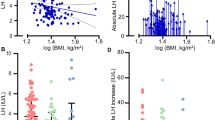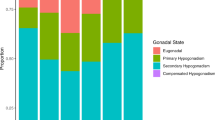Abstract
Obesity’s negative association with serum testosterone can be explained by either decreasing luteinizing hormone (LH) production from the pituitary gland and/or directly impacting intratesticular testosterone production. We hypothesize that obesity will negatively impact intratesticular testosterone levels when compared to those of non-obese men. We performed a cross-sectional analysis of men with symptoms of testosterone deficiency and male infertility between July 2018 and April 2020 to evaluate the association between body mass index (BMI) and age with intratesticular testosterone (using serum 17-hydroxyprogesterone (17-OHP) as a biomarker), and between BMI with LH. Univariable and multiple linear regression analysis were performed using confounding variables to predict 17-OHP and testosterone. A total of 340 men were selected. Median age was 38 [33–44] years, BMI 27.8 [25.4–31.1] kg/m2, serum testosterone 363 [256.3–469.6] ng/dl, 17-OHP 60.5 [39.3–85.8] ng/dl, and LH 4.2 [2.8–5.7] mIU/ml. Older and obese men had lower testosterone compared to younger and non-obese men. Interestingly, increasing age and higher BMI were associated with lower 17-OHP (p < 0.001). Contrarily, age and BMI were not associated with LH levels (p = 0.478). In conclusion, obesity and aging negatively affected 17-OHP independent of LH, suggesting a possible direct effect on testicular function, rather than a secondary effect from a decline in pituitary signaling.
This is a preview of subscription content, access via your institution
Access options
Subscribe to this journal
Receive 8 print issues and online access
$259.00 per year
only $32.38 per issue
Buy this article
- Purchase on Springer Link
- Instant access to full article PDF
Prices may be subject to local taxes which are calculated during checkout


Similar content being viewed by others
References
The Centers for Disease Control and Prevention. https://www.cdc.gov/nchs/products/databriefs/db360.htm. Accessed 26 Apr 2020.
Allen NE, Appleby PN, Davey GK, Key TJ. Lifestyle and nutritional determinants of bioavailable androgens and related hormones in British men. Cancer Causes Control. 2002;13:353–63.
Lokeshwar SD, Patel P, Fantus RJ, Halpern J, Chang C, Kargi AY, et al. Decline in serum testosterone levels among adolescent and young adult men in the USA. Eur Urol Focus. 2020. https://doi.org/10.1016/j.euf.2020.02.006.
Jensen TK, Andersson AM, Jørgensen N, Andersen AG, Carlsen E, Petersen JH, et al. Body mass index in relation to semen quality and reproductive hormones among 1,558 Danish men. Fertil Steril. 2004;82:863–70.
Svartberg J, von Mühlen D, Sundsfjord J, Jorde R. Waist circumference and testosterone levels in community dwelling men. The Tromsø Study. Eur J Epidemiol. 2004;19:657–63.
Glass AR, Swerdloff RS, Bray GA, Dahms WT, Atkinson RL. Low serum testosterone and sex-hormone-binding-globulin in massively obese men. J Clin Endocrinol Metab. 1977;45:1211–9.
Zumoff B, Strain GW, Miller LK, Rosner W, Senie R, Seres DS, et al. Plasma free and non sex-hormone-binding-globulin-bound testosterone are decreased in obese men in proportion to their degree of obesity. J Clin Endocrinol Metab. 1990;71:929–31.
Pasquali R, Casimirri F, Cantobelli S, Melchionda N, Morselli Labate AM, Fabbri R, et al. Effect of obesity and body fat distribution on sex hormones and insulin in men. Metabolism. 1991;40:101–4.
Kapoor D, Goodwin E, Channer KS, Jones TH. Testosterone replacement therapy improves insulin resistance, glycaemic control, visceral adiposity and hypercholesterolaemia in hypogonadal men with type 2 diabetes. Eur J Endocrinol. 2006;154:899–906.
Hackett G, Cole N, Bhartia M, Kennedy D, Raju J, Wilkinson P. Testosterone replacement therapy with long-acting testosterone undecanoate improves sexual function and quality-of-life parameters vs. placebo in a population of men with type 2 diabetes. J Sex Med. 2013;10:1612–27.
Lima TFN, Patel P, Blachman-Braun R, Madhusoodanan V, Ramasamy R. Serum 17-hydroxyprogesterone is a potential biomarker for evaluating intratesticular testosterone. J Urol. 2020. 101097JU0000000000001016.
Patel A, Patel P, Bitran J, Ramasamy R. Can serum 17-hydroxyprogesterone and insulin-like factor 3 be used as a marker for evaluation of intratesticular testosterone? Transl Androl Urol. 2019;8:S58–63.
Amory JK, Coviello AD, Page ST, Anawalt BD, Matsumoto AM, Bremner WJ. Serum 17-hydroxyprogesterone strongly correlates with intratesticular testosterone in gonadotropin-suppressed normal men receiving various dosages of human chorionic gonadotropin. Fertil Steril. 2008;89:380–6.
Chen H, Ge RS, Zirkin BR. Leydig cells: from stem cells to aging. Mol Cell Endocrinol. 2009;306:9–16.
The Centers for Disease Control and Prevention. https://www.cdc.gov/obesity/adult/defining.html. Accessed 26 Apr 2020.
Kort HI. Impact of body mass index values on sperm quantity and quality. J Androl. 2006;27:450–2.
Khodamoradi K, Parmar M, Khosravizadeh Z, Kuchakulla M, Manoharan M, Arora H. The role of leptin and obesity on male infertility. Curr Opin Urol. 2020;30:334–9.
Katib A. Mechanisms linking obesity with male infertility. Cent European J Urol. 2015;68. https://doi.org/10.5173/ceju.2015.01.435.
Zirkin BR, Santulli R, Awoniyi CA, Ewing LL. Maintenance of advanced spermatogenic cells in the adult rat testis: quantitative relationship to testosterone concentration within the testis. Endocrinology. 1989;124:3043.
Jarow JP, Kirkland J, Koritnik DR, Cefalu WT. Effect of obesity and fertility status on sex steroid levels in men. Urology. 1993;42:171–4.
Tenover J. Declining testicular function in aging men. Int J Impot Res. 2003;15:S3–8.
Sallmén M, Sandler DP, Hoppin JA, Blair A, Baird DD. Reduced fertility among overweight and obese men. Epidemiology. 2006;17:520–3. https://doi.org/10.1097/01.ede.0000229953.76862.e5.
Isidori AM, Caprio M, Strollo F, Moretti C, Frajese G, Isidori A, et al. Leptin and androgens in male obesity: evidence for leptin contribution to reduced androgen levels. J Clin Endocrinol Metab. 1999;84:3673–80.
Fui MN, Dupuis P, Grossmann M. Lowered testosterone in male obesity: mechanisms, morbidity and management. Asian J Androl. 2014;16:223–31.
Paduch DA, Brannigan RE, Fuchs EF, Kim ED, Marmar JL, Sandlow JI. The laboratory diagnosis of testosterone deficiency. Urology. 2014;83:980.
Blanchette S, Marceau P, Biron S, Brochu G, Tchernof A. Circulating progesterone and obesity in men. Horm Metab Res. 2006;38:330–5.
Author information
Authors and Affiliations
Corresponding author
Ethics declarations
Conflict of interest
The authors declare that they have no conflict of interest.
Additional information
Publisher’s note Springer Nature remains neutral with regard to jurisdictional claims in published maps and institutional affiliations.
Rights and permissions
About this article
Cite this article
Lima, T.F.N., Frech, F.S., Blachman-Braun, R. et al. Association of aging and obesity with decreased 17-hydroxyprogesterone, a serum biomarker of intratesticular testosterone. Int J Impot Res 34, 44–49 (2022). https://doi.org/10.1038/s41443-020-00358-8
Received:
Accepted:
Published:
Issue Date:
DOI: https://doi.org/10.1038/s41443-020-00358-8
This article is cited by
-
An update on male infertility and intratesticular testosterone—insight into novel serum biomarkers
International Journal of Impotence Research (2022)



